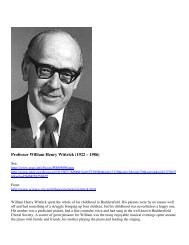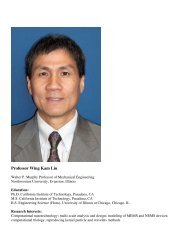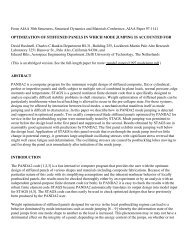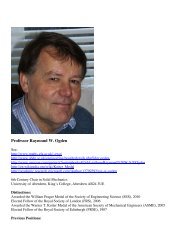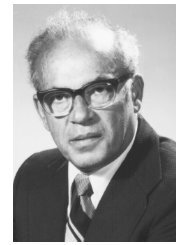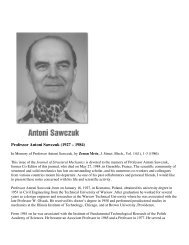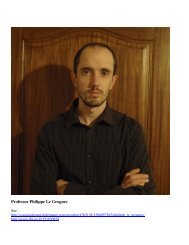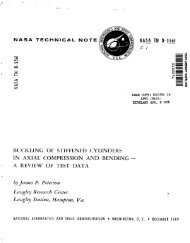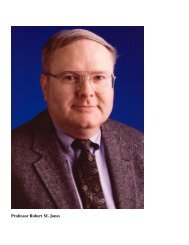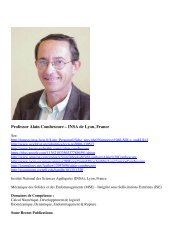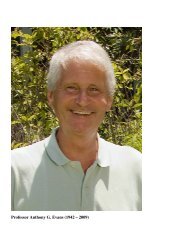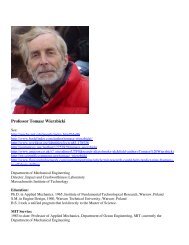Leonhard Euler (1707 â 1783) - Shellbuckling.com
Leonhard Euler (1707 â 1783) - Shellbuckling.com
Leonhard Euler (1707 â 1783) - Shellbuckling.com
Create successful ePaper yourself
Turn your PDF publications into a flip-book with our unique Google optimized e-Paper software.
<strong>Leonhard</strong> <strong>Euler</strong> (<strong>1707</strong> – <strong>1783</strong>)From Wikipedia, the free encyclopedia,http://en.wikipedia.org/wiki/<strong>Leonhard</strong>_<strong>Euler</strong><strong>Euler</strong> was a pioneering Swiss mathematician and physicist. He made important discoveries in fields as diverseas infinitesimal calculus and graph theory. He also introduced much of the modern mathematical terminologyand notation, particularly for mathematical analysis, such as the notion of a mathematical function. He is alsorenowned for his work in mechanics, fluid dynamics, optics, and astronomy.<strong>Euler</strong> spent most of his adult life in St. Petersburg, Russia, and in Berlin, Prussia. He is considered to be thepreeminent mathematician of the 18th century, and one of the greatest of all time. He is also one of the mostprolific mathematicians ever; his collected works fill 60 -80 quarto volumes. A statement attributed to Pierre-Simon Laplace expresses <strong>Euler</strong>'s influence on mathematics: "Read <strong>Euler</strong>, read <strong>Euler</strong>, he is the master of us all."<strong>Euler</strong> was born on April 15, <strong>1707</strong>, in Basel to Paul <strong>Euler</strong>, a pastor of the Reformed Church. His mother wasMarguerite Brucker, a pastor's daughter. He had two younger sisters named Anna Maria and Maria Magdalena.Soon after the birth of <strong>Leonhard</strong>, the <strong>Euler</strong>s moved from Basel to the town of Riehen, where <strong>Euler</strong> spent most ofhis childhood. Paul <strong>Euler</strong> was a friend of the Bernoulli family - Johann Bernoulli, who was then regarded as
Europe's foremost mathematician, would eventually be the most important influence on young <strong>Leonhard</strong>.<strong>Euler</strong>'s early formal education started in Basel, where he was sent to live with his maternal grandmother. At theage of thirteen he enrolled at the University of Basel, and in 1723, received his Master of Philosophy with adissertation that <strong>com</strong>pared the philosophies of Descartes and Newton. At this time, he was receiving Saturdayafternoon lessons from Johann Bernoulli, who quickly discovered his new pupil's incredible talent formathematics. <strong>Euler</strong> was at this point studying theology, Greek, and Hebrew at his father's urging, in order tobe<strong>com</strong>e a pastor, but Bernoulli convinced Paul <strong>Euler</strong> that <strong>Leonhard</strong> was destined to be<strong>com</strong>e a greatmathematician. In 1726, <strong>Euler</strong> <strong>com</strong>pleted a dissertation on the propagation of sound with the title De Sono. Atthat time, he was pursuing an (ultimately unsuccessful) attempt to obtain a position at the University of Basel.In 1727, he entered the Paris Academy Prize Problem <strong>com</strong>petition, where the problem that year was to find thebest way to place the masts on a ship. He won second place, losing only to Pierre Bouguer -a man now knownas "the father of naval architecture". <strong>Euler</strong> subsequently won this coveted annual prize twelve times in hiscareer.Around this time Johann Bernoulli's two sons, Daniel and Nicolas, were working at the Imperial RussianAcademy of Sciences in St Petersburg. On July 10, 1726, Nicolas died of appendicitis after spending a year inRussia, and when Daniel assumed his brother's position in the mathematics/physics division, he re<strong>com</strong>mendedthat the post in physiology that he had vacated be filled by his friend <strong>Euler</strong>. In November 1726 <strong>Euler</strong> eagerlyaccepted the offer, but delayed making the trip to St Petersburg while he unsuccessfully applied for a physicsprofessorship at the University of Basel.<strong>Euler</strong> arrived in the Russian capital on 17 May 1727. He was promoted from his junior post in the medicaldepartment of the academy to a position in the mathematics department. He lodged with Daniel Bernoulli withwhom he often worked in close collaboration. <strong>Euler</strong> mastered Russian and settled into life in St Petersburg. Healso took on an additional job as a medic in the Russian Navy.The Academy at St. Petersburg, established by Peter the Great, was intended to improve education in Russiaand to close the scientific gap with Western Europe. As a result, it was made especially attractive to foreignscholars like <strong>Euler</strong>. The academy possessed ample financial resources and a <strong>com</strong>prehensive library drawn fromthe private libraries of Peter himself and of the nobility. Very few students were enrolled in the academy inorder to lessen the faculty's teaching burden, and the academy emphasized research and offered to its facultyboth the time and the freedom to pursue scientific questions.The Academy's benefactress, Catherine I, who had continued the progressive policies of her late husband, diedon the day of <strong>Euler</strong>'s arrival. The Russian nobility then gained power upon the ascension of the twelve-year-oldPeter II. The nobility were suspicious of the academy's foreign scientists, and thus cut funding and caused otherdifficulties for <strong>Euler</strong> and his colleagues.Conditions improved slightly upon the death of Peter II, and <strong>Euler</strong> swiftly rose through the ranks in theacademy and was made professor of physics in 1731. Two years later, Daniel Bernoulli, who was fed up withthe censorship and hostility he faced at St. Petersburg, left for Basel. <strong>Euler</strong> succeeded him as the head of themathematics department.On 7 January 1734, he married Katharina Gsell (<strong>1707</strong> _1773), a daughter of Georg Gsell, a painter from theAcademy Gymnasium. The young couple bought a house by the Neva River. Of their thirteen children, onlyfive survived childhood.
Concerned about the continuing turmoil in Russia, <strong>Euler</strong> left St. Petersburg on 19 June 1741 to take up a post atthe Berlin Academy, which he had been offered by Frederick the Great of Prussia. He lived for twenty-fiveyears in Berlin, where he wrote over 380 articles. In Berlin, he published the two works which he would bemost renowned for: the Introductio in analysin infinitorum, a text on functions published in 1748, and theInstitutiones calculi differentialis, published in 1755 on differential calculus. In 1755, he was elected a foreignmember of the Royal Swedish Academy of Sciences.In addition, <strong>Euler</strong> was asked to tutor the Princess of Anhalt-Dessau, Frederick's niece. <strong>Euler</strong> wrote over 200letters to her, which were later <strong>com</strong>piled into a best-selling volume entitled Letters of <strong>Euler</strong> on differentSubjects in Natural Philosophy Addressed to a German Princess. This work contained <strong>Euler</strong>'s exposition onvarious subjects pertaining to physics and mathematics, as well as offering valuable insights into <strong>Euler</strong>'spersonality and religious beliefs. This book became more widely read than any of his mathematical works, andit was published across Europe and in the United States. The popularity of the 'Letters' testifies to <strong>Euler</strong>'s abilityto <strong>com</strong>municate scientific matters effectively to a lay audience, a rare ability for a dedicated research scientist.Despite <strong>Euler</strong>'s immense contribution to the Academy's prestige, he was eventually forced to leave Berlin. Thiswas partly because of a conflict of personality with Frederick, who came to regard <strong>Euler</strong> as unsophisticated,especially in <strong>com</strong>parison to the circle of philosophers the German king brought to the Academy. Voltaire wasamong those in Frederick's employ, and the Frenchman enjoyed a prominent position in the king's social circle.<strong>Euler</strong>, a simple religious man and a hard worker, was very conventional in his beliefs and tastes. He was inmany ways the direct opposite of Voltaire. <strong>Euler</strong> had limited training in rhetoric, and tended to debate mattersthat he knew little about, making him a frequent target of Voltaire's wit. Frederick also expresseddisappointment with <strong>Euler</strong>'s practical engineering abilities:“I wanted to have a water jet in my garden: <strong>Euler</strong> calculated the force of the wheels necessary to raise thewater to a reservoir, from where it should fall back through channels, finally spurting out in Sanssouci. My millwas carried out geometrically and could not raise a mouthful of water closer than fifty paces to the reservoir.Vanity of vanities! Vanity of geometry!”<strong>Euler</strong>'s eyesight worsened throughout his mathematical career. Three years after suffering a near-fatal fever in1735 he became nearly blind in his right eye, but <strong>Euler</strong> rather blamed his condition on the painstaking work oncartography he performed for the St. Petersburg Academy. <strong>Euler</strong>'s sight in that eye worsened throughout hisstay in Germany, so much so that Frederick referred to him as "Cyclops". <strong>Euler</strong> later suffered a cataract in hisgood left eye, rendering him almost totally blind a few weeks after its discovery in 1766. Even so, his conditionappeared to have little effect on his productivity, as he <strong>com</strong>pensated for it with his mental calculation skills andphotographic memory. For example, <strong>Euler</strong> could repeat the Aeneid of Virgil from beginning to end withouthesitation, and for every page in the edition he could indicate which line was the first and which the last. Withthe aid of his scribes, <strong>Euler</strong>'s productivity on many areas of study actually increased. He produced on averageone mathematical paper every week in the year 1775.The situation in Russia had improved greatly since the accession to the throne of Catherine the Great, and in1766 <strong>Euler</strong> accepted an invitation to return to the St. Petersburg Academy and spent the rest of his life inRussia. His second stay in the country was marred by tragedy. A fire in St. Petersburg in 1771 cost him hishome, and almost his life. In 1773, he lost his wife Katharina after 40 years of marriage. Three years after hiswife's death <strong>Euler</strong> married her half sister, Salome Abigail Gsell (1723 _1794). This marriage lasted until his
death.In St Petersburg on 18 September <strong>1783</strong>, after a lunch with his family, during a conversation with a fellowacademician Anders Johan Lexell about the newly-discovered Uranus and its orbit, <strong>Euler</strong> suffered a brainhemorrhage and died a few hours later. A short obituary for the Russian Academy of Sciences was written byJacob von Shtelin and a more detailed eulogy was written and delivered at a memorial meeting by Russianmathematician Nicolas Fuss, one of the <strong>Euler</strong>'s disciples. In the eulogy written for the French Academy by theFrench mathematician and philosopher Marquis de Condorcet, he <strong>com</strong>mented,“...il cessa de calculer et de vivre _... he ceased to calculate and to live.”He was buried next to Katharina at the Smolensk Lutheran Cemetery on Vasilievsky Island. In 1785, theRussian Academy of Sciences put a marble bust of <strong>Leonhard</strong> <strong>Euler</strong> on a pedestal next to the Director's seat and,in 1837, placed a headstone on <strong>Euler</strong>'s grave. To <strong>com</strong>memorate the 250th anniversary of <strong>Euler</strong>'s birth, theheadstone was moved in 1956, together with his remains, to the 18th-century necropolis at the AlexanderNevsky Monastery.<strong>Euler</strong> worked in almost all areas of mathematics: geometry, infinitesimal calculus, trigonometry, algebra, andnumber theory, as well as continuum physics, lunar theory and other areas of physics. He is a seminal figure inthe history of mathematics; if printed, his works, many of which are of fundamental interest, would occupybetween 60 and 80 quarto volumes. <strong>Euler</strong>'s name is associated with a large number of topics.<strong>Euler</strong> introduced and popularized several notational conventions through his numerous and widely circulatedtextbooks. Most notably, he introduced the concept of a function and was the first to write f(x) to denote thefunction f applied to the argument x. He also introduced the modern notation for the trigonometric functions,the letter e for the base of the natural logarithm (now also known as <strong>Euler</strong>'s number), the Greek letter ∑forsummations and the letter i to denote the imaginary unit. The use of the Greek letter π to denote the ratio of acircle's circumference to its diameter was also popularized by <strong>Euler</strong>, although it did not originate with him.The development of infinitesimal calculus was at the forefront of 18th Century mathematical research, and theBernoullis -family friends of <strong>Euler</strong>- were responsible for much of the early progress in the field. Thanks to theirinfluence, studying calculus became the major focus of <strong>Euler</strong>'s work. While some of <strong>Euler</strong>'s proofs are notacceptable by modern standards of mathematical rigour (in particular his reliance on the principle of thegenerality of algebra), his ideas led to many great advances. <strong>Euler</strong> is well known in analysis for his frequent useand development of power series, the expression of functions as sums of infinitely many terms.<strong>Euler</strong> introduced the use of the exponential function and logarithms in analytic proofs. He discovered ways toexpress various logarithmic functions using power series, and he successfully defined logarithms for negativeand <strong>com</strong>plex numbers, thus greatly expanding the scope of mathematical applications of logarithms. He alsodefined the exponential function for <strong>com</strong>plex numbers, and discovered its relation to the trigonometricfunctions.In addition, <strong>Euler</strong> elaborated the theory of higher transcendental functions by introducing the gamma functionand introduced a new method for solving quartic equations. He also found a way to calculate integrals with<strong>com</strong>plex limits, foreshadowing the development of modern <strong>com</strong>plex analysis. He also invented the calculus ofvariations including its best-known result, the <strong>Euler</strong>-Lagrange equation.
<strong>Euler</strong> also pioneered the use of analytic methods to solve number theory problems. In doing so, he united twodisparate branches of mathematics and introduced a new field of study, analytic number theory. In breakingground for this new field, <strong>Euler</strong> created the theory of hypergeometric series, q-series, hyperbolic trigonometricfunctions and the analytic theory of continued fractions. For example, he proved the infinitude of primes usingthe divergence of the harmonic series, and he used analytic methods to gain some understanding of the wayprime numbers are distributed. <strong>Euler</strong>'s work in this area led to the development of the prime number theorem.Some of <strong>Euler</strong>'s greatest successes were in solving real-world problems analytically, and in describingnumerous applications of the Bernoulli numbers, Fourier series, Venn diagrams, <strong>Euler</strong> numbers, the constants eand π, continued fractions and integrals. He integrated Leibniz's differential calculus with Newton's Method ofFluxions, and developed tools that made it easier to apply calculus to physical problems. He made great stridesin improving the numerical approximation of integrals, inventing what are now known as the <strong>Euler</strong>approximations. The most notable of these approximations are <strong>Euler</strong>'s method and the <strong>Euler</strong>-Maclaurin formula.<strong>Euler</strong> helped develop the <strong>Euler</strong>-Bernoulli beam equation, which became a cornerstone of engineering. Asidefrom successfully applying his analytic tools to problems in classical mechanics, <strong>Euler</strong> also applied thesetechniques to celestial problems. His work in astronomy was recognized by a number of Paris Academy Prizesover the course of his career. His ac<strong>com</strong>plishments include determining with great accuracy the orbits of <strong>com</strong>etsand other celestial bodies, understanding the nature of <strong>com</strong>ets, and calculating the parallax of the sun. Hiscalculations also contributed to the development of accurate longitude tables.In addition, <strong>Euler</strong> made important contributions in optics. He disagreed with Newton's corpuscular theory oflight in the Opticks, which was then the prevailing theory. His 1740s papers on optics helped ensure that thewave theory of light proposed by Christian Huygens would be<strong>com</strong>e the dominant mode of thought, at least untilthe development of the quantum theory of light.In 1757 he published an important set of equations for inviscid flow, that are now known as the <strong>Euler</strong> equations.<strong>Euler</strong> has an extensive bibliography. His best known books include:Elements of Algebra. This elementary algebra text starts with a discussion of the nature of numbers and givesa <strong>com</strong>prehensive introduction to algebra, including formulae for solutions of polynomial equations.Introductio in analysin infinitorum (1748). English translation Introduction to Analysis of the Infinite by JohnBlanton (Book I, ISBN 0-387-96824-5, Springer-Verlag 1988; Book II, ISBN 0-387-97132-7, Springer-Verlag1989).Two influential textbooks on calculus: Institutiones calculi differentialis (1755) and Institutionum calculiintegralis (1768 _1770).Lettres à une Princesse d'Allemagne (Letters to a German Princess) (1768 -1772). Available online (inFrench). English translation, with notes, and a life of <strong>Euler</strong>, available online from Google Books: Volume 1,Volume 2Methodus inveniendi lineas curvas maximi minimive proprietate gaudentes, sive solutio problematisisoperimetrici latissimo sensu accepti (1744). The Latin title translates as a method for finding curved linesenjoying properties of maximum or minimum, or solution of isoperimetric problems in the broadest acceptedsense.A definitive collection of <strong>Euler</strong>'s works, entitled Opera Omnia, has been published since 1911 by the <strong>Euler</strong>Commission of the Swiss Academy of Sciences.



